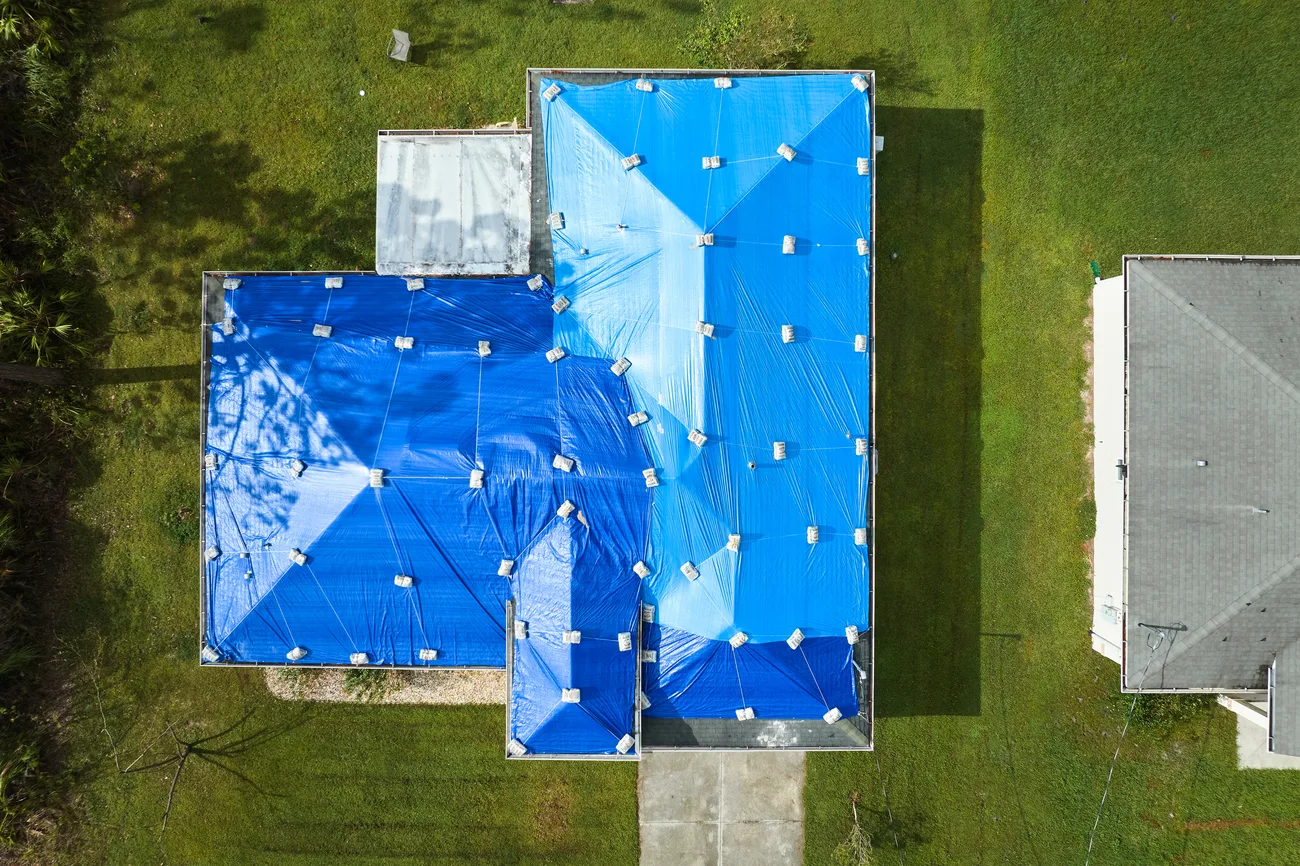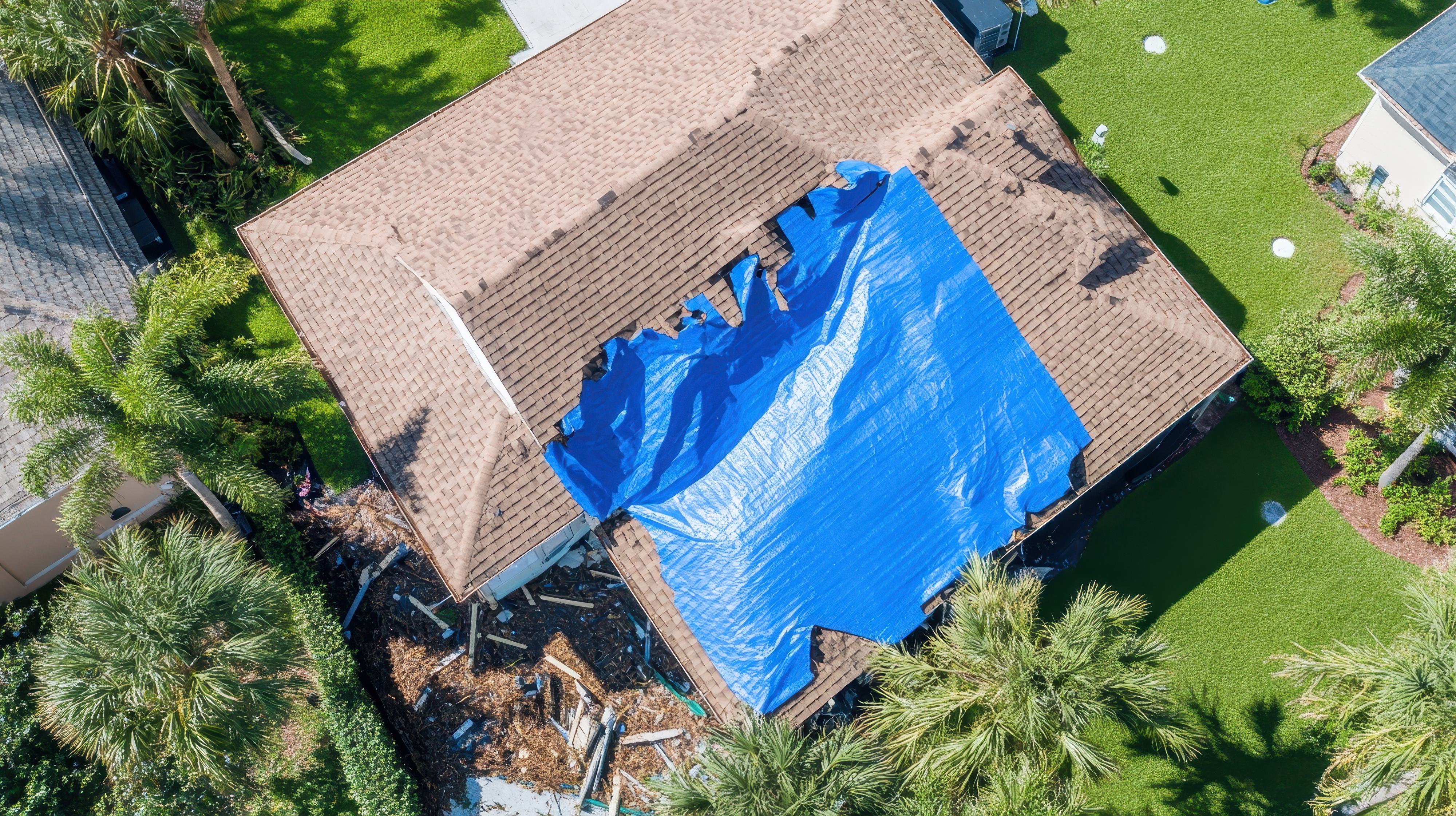
Product Guide
How to Tarp a Roof Safely
Guide to Tarping Your Roof After Storm or Leaks

Tarping a roof is a critical temporary solution after storm damage or leaks, providing protection until permanent repairs can be made. When installed correctly, it keeps out additional water, safeguards the interior, and can even support insurance claims. This guide outlines a clear, safety-first process to help you tarp the roof effectively and responsibly.
Safety First: Before You Climb
Know When to Wait or Call a Pro
If your roof is showing signs of instability, such as sagging, or bad weather is approaching, it is safer to leave the task of tarping to the professionals.
Use Proper Safety Gear
Wear solid non-slip boots, gloves, eye protection, and a helmet. If the slope exceeds 4:12, utilize fall protection like harnesses, guardrails, or safety nets.
Avoid Storms and Unstable Conditions
Never attempt tarping a roof during rain, high winds, or while the roof is wet. Wait for calm conditions.
Stabilize Your Ladder Correctly
Set your ladder at a 4:1 angle (one foot out for every four feet up) and extend it three feet beyond the roof edge for safe access.
Always Work With a Partner
Tarping is never a solo task. Two-person teams improve safety and help with handling the roof tarp and other materials efficiently.
Tools & Planning Checklist for Tarping a Roof
| Item | Purpose |
| Heavy-duty roofing tarp | Provides robust temporary coverage |
| Tape measure | To ensure accurate fit and coverage |
| Wooden boards | 2x4s to anchor the edges effectively |
| Nail or screws | For securing the wooden anchor boards |
| Debris removal tools | Broom or roof rake to clear loose debris |
| Camera phone | Document damage for insurance purposes |

Roofing Tarp Installation Steps
1. Assess & Measure the Damaged Area
Start by measuring the damaged section of your roof. Add a 4–5 ft overlap on all sides. On sloped surfaces, make sure the tarp for roof spans the ridge line for better water runoff.
2. Clear Debris Thoroughly
Remove leaves, branches, and any loose shingles. A clean surface ensures proper contact between the tarp and roof, avoiding pockets where water can accumulate.
3. Position the Tarp Accurately
Lay the roof tarp flat and centered over the damaged area. Make sure it extends beyond the edges and lies smoothly without wrinkles or folds.
4. Anchor with Wooden Boards
Wrap the edge of the tarp around a 2×4 board and screw it into the decking (not just the shingles). Repeat on all sides to secure the tarp roof properly.
5. Optional Reinforcements
For added hold, place sandbags or use adhesive tape at corners or along seams. While convenient, these methods are best for calm weather or flat roofs.
6. Inspect & Test Security
Gently pull at the tarp edges to check for secure anchoring. Ensure the roof tarp is tight and won’t flap or loosen during the next storm.
Common Mistakes to Avoid
- Insufficient Overhang: A tarp with less than 3–4 ft of overhang may not effectively protect the area. Always extend coverage generously.
- Direct Nailing Without Board: Nailing the tarp on roof directly through shingles can lead to more damage. Always use anchor boards.
- Narrow or Thin Tarps: Choose a thick, waterproof tarp for roof use, thin plastic or camping tarps tear quickly and fail under harsh conditions.
- Tarping in Unsafe Conditions: Do not attempt tarping a roof during high winds, storms, or if your footing is uncertain.
- Leaving Tarp On Too Long: The tarp roof solution is temporary. Prolonged use (beyond 90 days) may lead to further damage and void insurance claims.

Aftercare & Maintenance
- Regular Inspections: Check your roof tarp after each major storm. Ensure that boards are still secure and the tarp hasn’t shifted or torn.
- Document Everything: Take photos before and after placing the tarp on roof. This will help with insurance claims and repair planning.
- Plan for Permanent Repair Promptly: Do not rely on the roofing tarp as a long-term fix. Schedule professional repairs as soon as possible, ideally within 90 days.
Tarping a roof safely is one of the most important short-term actions you can take after a storm or leak. By using the right materials, understanding the proper installation steps, and avoiding common mistakes, you can protect your home from further damage.
Frequently Asked Questions About Tarping a Roof
How long can a tarp safely stay on a roof?
Up to 90 days is typical. After that, replace it or install a new roof tarp to avoid deterioration.
Can I secure a tarp without nails?
Yes. Sandbags, ropes, or industrial-strength adhesives can temporarily hold the tarp on roof, but boards are much more reliable.
How do I tarp around chimneys or vents?
Cut and fit the tarp for the roof carefully around chimneys, using roofing tape to seal gaps and prevent leaks.
What should I tell my roofer or insurance provider?
Share photos and measurements showing how you’ve secured the tarp roof. This evidence supports your claim and shows proactive mitigation.
Get a Free Quote
Ready to order or looking for more info? We’re here to help!Questions?
Call Us Today!
Visit Us
Pennsylvania:
5000 Paschall Ave
Philadelphia, PA 19134
Indiana:
11 Lousisa St.
Gosport, IN 47433


